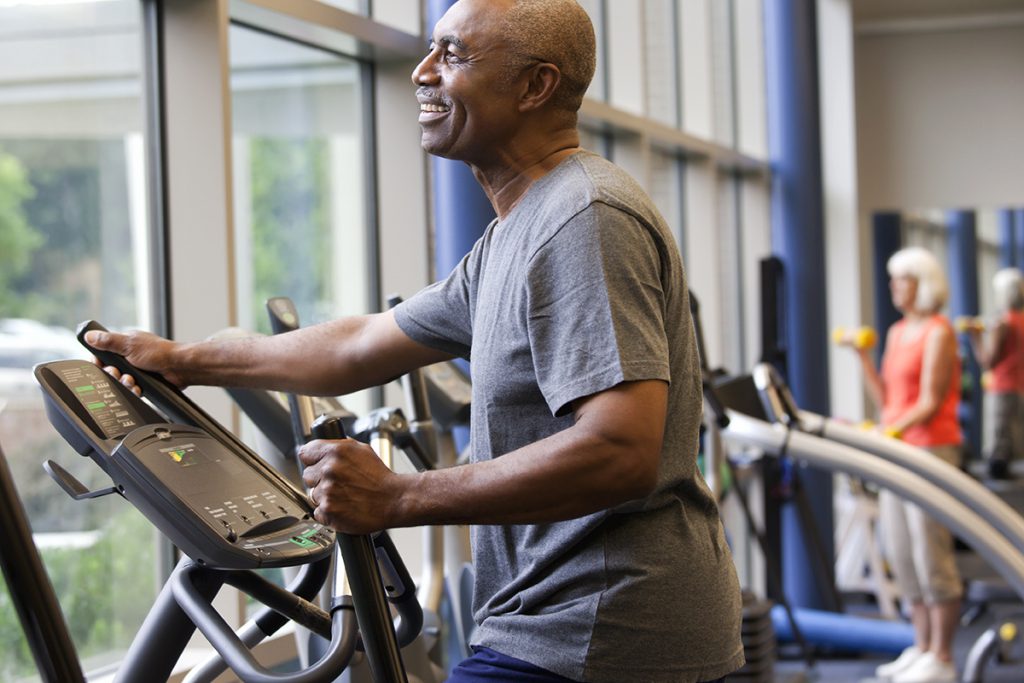7 Ways to Make Your Elliptical Workout More Effective
Get more out of your cardio routine with these small tweaks—no extra time or equipment needed.

When you head back to the gym after some time away, it can be tempting to slip back into your old routine. But there’s a good chance you could be getting even more from your time at the gym—especially if your go-to workout involves the elliptical machine.
“The elliptical machine is a great option for cardio workouts because it’s much easier on your joints than machines like the stair stepper or treadmill,” says Chris Freytag, C.P.T., founder of GetHealthyU.com.
The impact involved is virtually nonexistent, adds exercise physiologist Pete McCall, C.S.C.S. Everything is just one smooth motion, which is ideal for people with cranky ankles, knees, or osteoarthritis.
So what’s the problem? Elliptical workouts are incredibly easy to phone in. The momentum of those sliding pedals can take over, and you end up getting far less out of your cardio session than you want—or your body deserves, McCall says.
Not anymore. Here, McCall and Freytag share their best advice for making your elliptical workout much more effective.
Upgrade #1: Stand Up Straight
Slouching is the quickest way to ruin your elliptical session. “Stand up straight to lengthen your trunk. It engages your core and even works some of your upper-body muscles, such as your biceps, triceps, and shoulders,” Freytag says.
The result: You strengthen your postural muscles, decrease your risk for back and shoulder pain, and even burn more calories, McCall says. If you want help to improve your posture in and out of the gym, check out our four-step plan for standing taller.
Upgrade #2: Keep Your Whole Foot on the Pedal
The next time you’re on the elliptical, pay attention to your toes. Putting too much pressure on your toes can cause your heels to lift up, lead to numbness in your feet, and even decrease your calorie burn by limiting the number of muscles you work, McCall says.
The fix: Focus on keeping your heel in contact with the pedals and pushing through your entire foot with each stride. Freytag explains that this will help engage the powerhouse muscles in your lower body, including your quads and glutes.
If you find that uncomfortable, McCall suggests wearing a running sneaker with an elevated heel rather than a flat training shoe. For more guidance, check out these five steps to finding the right workout shoes for you.
Upgrade #3: Hold on Tight
Most gyms offer two different kinds of elliptical machines: those with handles and those without handles. When you have the option to use a machine with an upper-body component, Freytag recommends that you choose that machine.
“Holding the handles and moving your arms activates not only your arm muscles, but also your back, shoulders, and core,” she says. Remember: The more muscle groups you engage, the more your body benefits.
“To make sure you’re actually engaging your arms and back instead of just taking them along for the ride, try to actively press and pull the handles,” she says. If that’s too tiring, try using the moving handles for one minute, then hold the stationary handles for two to three minutes before pumping your arms once more.
Upgrade #4: Mix Up Your Workouts
Most machines have two variable settings: resistance and incline. Dialing up the resistance is a great way to work your muscles harder to power every movement, Freytag says.
As you increase the resistance, don’t be surprised if you have to pedal slower, she says. It should be tougher, and you’ll feel exhausted quicker. So if you’re short on time, up the resistance for a faster, effective workout.
The incline affects which muscles handle the brunt of the work, McCall explains. For example, a higher incline gets the glutes and the quads working, while a lower incline targets your hamstrings and calves. If you’re using the elliptical two days in a row, alternate between high and low inclines to keep from overworking any one muscle group, he suggests.
With both resistance and incline, start small and make sure you feel comfortable and steady before increasing either further. Going up in increments of two at a time is a good rule of thumb.
Upgrade #5: Take the Talk Test
It’s tempting to simply watch the elliptical monitor to know how hard you’re working. But there’s a better and more accurate way: Listen to your body and give it what it needs. The talk test is the easiest way to do this.
How it works: If you can say a couple sentences at a time without feeling out of breath, you’re in the moderate-intensity exercise zone. If you can barely get out a few words—maybe one short sentence—without needing to take a breath, you’re in the high-intensity zone, Freytag says.
She recommends starting with moderate-intensity exercise and slowly playing with resistance and speed to increase intensity. Over time, as you feel able, try to exercise at a level somewhere between moderate and high. You should be able to speak one to two sentences at a time before needing to take a breath.
And remember: It’s always a good idea to talk to your doctor before pushing the intensity too much.
Subscribe to our newsletter
It's quick and easy. You could be one of the 13 million people who are eligible.
Already a member? Click to discover our 15,000+ participating locations.
Follow Us
Upgrade #6: Make Your Entertainment Work for You
“If you’re flipping through TV channels or reading a book, you’re probably not working at a high or even moderate intensity,” McCall says. But if reading or watching a show helps motivate you to show up for the gym, don’t ditch your entertainment entirely, he says.
“It’s okay to tune in, as long as you keep reminding yourself to pay attention to your body,” Freytag adds.
One suggestion: During commercial breaks, focus on your form and increase your resistance and speed. Then, when your show comes back on (and you’re likely distracted), lower the resistance and use that time to recover and get ready for the next round of commercials.
Similarly, depending on how quickly you read, you might decide to go hard for one minute, then lower the intensity and read a handful of pages of your book or magazine, and repeat.
Upgrade #7: Add Intervals
High-intensity interval training (HIIT) is a style of exercise in which you alternate between periods of almost all-out effort and low effort. And it’s a great way to get the most out of your elliptical workout.
“The high-intensity intervals push your body toward its metabolic limits, and the low-intensity intervals allow it to recover and catch your breath,” McCall explains. As a result, you burn more calories in less time and also stand to build more strength and lean muscle than you would with steady-state cardio.
When getting started with intervals, use caution and stick with short high-intensity periods and longer low- to moderate-intensity ones. For example, you could try going all out for 30 seconds, and then moving to a recovery pace for a full minute or two, and repeat this pattern up to six times.
As you progress, lengthen your work segments, and shorten your recovery sessions. Use the talk test and listen to your body to gauge intensity and adjust as needed. If you ever feel uncomfortable or that you are too fatigued to use good form, stop and rest.
Check Your SilverSneakers Eligibility Instantly
SilverSneakers members can go to thousands of gyms and fitness locations across the nation, plus take SilverSneakers LIVE online classes that are designed for seniors of all levels. If you have a Medicare plan, it may include SilverSneakers—at no additional cost. Check your eligibility instantly here.
Not eligible for SilverSneakers? You can still get 200+ free SilverSneakers On-Demand videos and stay in touch with us by creating your online account.





